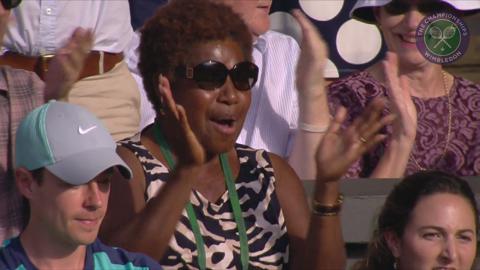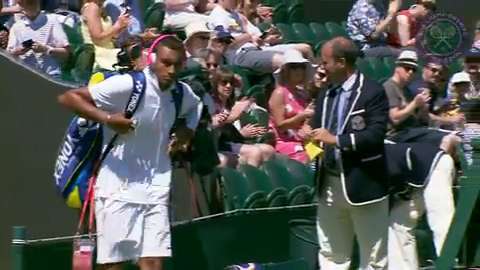Wimbledon was moved back a week this year, to give the players a little more turnaround time after the French Open. One unintended, positive consequence of that shift for those of us in the States is that the middle of the tournament now falls over our July 4th weekend. Strawberries and cream may never replace hot dogs and potato salad as the official food of our Independence Day, but on Friday fans and non-fans around the US had a chance to spend their morning watching as much tennis as they pleased.
Which was convenient, because this was another one of those “there’s too much going on” days at Wimbledon. For a while, it looked as if Nick Kyrgios would be the player of the day, but by the time Serena Williams and home favourite Heather Watson were shaking hands on Centre Court, the young Aussie’s triumph over Milos Raonic was long forgotten on the grounds. But they were two stories worth recording and remembering.
Henman Hill Becomes Heather's Hill
There was a lot happening at Wimbledon on Friday, until the match between Williams and Watson reached the middle of the second set. Then, for the next hour-and-a-half, there was nothing else going on. This was the only thing that mattered, and the noise from the crowd fairly burst out of Centre Court. By the end of the match, Henman Hill had been rechristened Heather's Hill.
It didn’t start out looking like a classic, as Watson appeared to be hopelessly overmatched through the first set. Then the Brit somehow found a way underneath the more powerful American’s game. Watson stayed low as she scampered quietly across the grass, and kept the ball even lower with her perfectly measured slice forehands and angled backhands. She forced Serena to hit up on her shots from the baseline, and slid the ball at her feet when she came to the net.
That was all it took to take Williams, who has been no stranger to nervous mid-match dips in form recently, out of her rhythm. She stood flat-footed and struggled to swing smoothly; while the scorekeepers at Wimbledon are famous for being generous in how they judge unforced errors, there was no mistaking these. If the ball wasn’t sailing off Serena’s racket, it was being smothered into the net.
Everybody gets tight, but what separates Serena is her ability to swing through the brick wall of nerves and loosen herself back up before it’s too late. From 3-3 in the third set, the momentum swung and swirled with each game. Serena’s attack ran headlong into Watson’s ever-more-resourceful defenses. When the Brit came up with an ace at break point while serving for the match, Serena nodded her approval.
Then she beat her. Afterwards, Serena, in a reference to the boisterous crowd, said she was facing “a few opponents” out there. When she was briefly booed for questioning a call, she waved her finger and told the audience, “Don’t try me.” It was that kind of day in Centre Court, a day like few others there. The crowd knew it, too: When Williams and Watson walked off together, the fans raised their hands and voices to applaud the efforts of both women.
The Kyrgios Question
Have we concluded whether Kyrgios is “good for the game” yet? Just when you think you have an answer, he turns around and makes you think again. Watch him banter laughingly with a fan and you wonder why anyone would object to an exuberant young man who engages the crowd and brings them inside a match. Then you watch him, a few minutes later, slam his racket into the grass hard enough that it bounces into the crowd and nearly hits someone in the third row, and you wonder if he isn’t a little over-exuberant for the fans’ good. Like the legendary male characters of old – Ilie Nastase, Jimmy Connors, John McEnroe – Kyrgios’s brand of entertainment comes with a hard edge.
But tennis is a hard-edged sport and, as I wrote earlier this week, the best and most entertaining part of Kyrgios is his game itself. There were plenty of memorable aspects to his four-set win over Raonic on Friday. The sleeve he wore over his left arm. The salute he gave his Aussie Fanatics before the match. The coloured Wimbledon headband that he was forced to turn inside out. The conversation he had with a fan about whether a ball had been in or out. The joyously maniacal way he leapt across the court when he won the fourth set. But most memorable, and useful, of all was the way his ground strokes became more technically sound – cleaner – as the pressure grew in each set.

Nick Kyrgios
When the rallies don’t matter as much, Kyrgios can look a little lackadaisical on his backhand, and he can overhit on his forehand. But when he needed a point today, he ripped through the ball with total confidence and passed Raonic at will from both sides. This is the opposite of what happens with most players, and even most pros; our technique breaks down or tightens up under pressure. If there’s a mark of a future champion in Kyrgios, it’s his ability to use pressure to clear his mind and clarify his game.
Kyrgios and Raonic was a highly-anticipated match, but it was put on No.2 Court, while Grigor Dimitrov and Richard Gasquet were handed the plumb assignment of Centre Court.
Dimitrov and Gasquet both have what old-school tennis fans like to call “glorious one-handed backhands”, but those backhands were no match for Kyrgios when it came to entertainment value today. While Dimitrov and Gasquet came and went quickly and quietly, “Kyrgios” spent a solid couple of hours trending on Twitter worldwide. I’d say that’s good for the game.










































